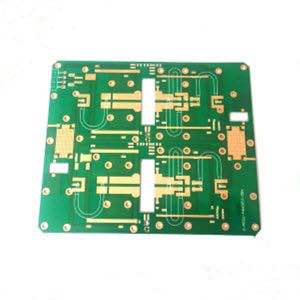
ROGERS 4360G2 PCB
РО4360G2™
High Frequency Laminates
We buy these materials from an agent at Rogers Materials and then process and produce blank circuit boards. We don’t produce core materials. The following information is for reference only.
РО4360G2™ laminates are 6.15 Дк, низкие потери, glass-reinforced, hydrocarbon ceramic-fifi lled thermoset materials that provide the ideal balance of performance and processing ease. RO4360G2 laminates extend Rogers’ portfolio of high performance materials by providing customers with a product that is lead-free process capable and offers better rigidity for improved processability in multi-layer board constructions, while reducing material and fabrication costs.
RO4360G2 laminates process similar to FR-4 and are automated assembly compatible. They have a low Z-axis CTE for design flfl exibility and have the same high Tg as all of the RO4000 product line. RO4360G2 laminates can be paired with RO4400™ prepreg and lower-Dk RO4000 laminate in multi-layer designs.
RO4360G2 laminates, with a Dk of 6.15 (Design Dk 6.4), allow designers to reduce circuit dimensions in applications where size and cost are critical. They are the best value choice for engineers working on designs including power amplififi ers, patch antennas, ground-based radar, and other general RF applications.
| Свойство Типичный Value Direction Units Состояние Test Method РО4360G2 | |||||
| Dielectric Constant, er (Process Specification) | 6.15 ± 0.15 | Z | 10 GHz/23°C | ИПК-ТМ-650 2.5.5.5 (2) Clamped Stripline | |
| 2.5 GHz/23°C | |||||
| Dissipation Factor | 0.0038 | Z | 10 GHz/23°C | ИПК-ТМ-650, 2.5.5.5 | |
| Теплопроводность | 0.75 | W/m/K | 50°С | ASTM D-5470 | |
| Volume Resistivity | 4.0 x 1013 | Ω•cm | Elevated T | ИПК-ТМ-650, 2.5.17.1 | |
| Surface Resistivity | 9.0 x 1012 | Ω | Elevated T | ИПК-ТМ-650, 2.5.17.1 | |
| Electrical Strength | 784 | Z | V/mil | ИПК-ТМ-650, 2.5.6.2 | |
| Tensile Strength | 131 (19) 97 (14) | X Y | МПа (kpsi) | 40 hrs 50%RH/23°C | ASTM D638 |
| Flexural Strength | 213 (31) 145 (21) | X Y | МПа (kpsi) | 40 hrs 50%RH/23°C | ИПК-ТМ-650, 2.4.4 |
| Coefficient of Thermal Expansion | 13 | Х | ppm/°C | -50°C to 288°C After Replicated Heat Cycle | ИПК-ТМ-650, 2.1.41 |
| 14 | Да | ||||
| 28 | Z | ||||
| Тг | >280 | °C TMA | N/A | ИПК-ТМ-650 2.4.24.3 | |
| Тд | 407°С | °С | N/A | ASTM D3850 using TGA | |
| Т288 | >30 | Z | мин | 30 мин / 125°C Prebake | ИПК-ТМ-650 2.4.24.1 |
| Moisture Absorption | 0.08 | % | 50°C/48hr | ИПК-ТМ-650 2.6.2.1 ASTM D570 | |
| Thermal Coefficient of er | -131 @ 10 ГГц | Z | ppm/°C | -50°C to 150°C | ИПК-ТМ-650, 2.5.5.5 |
| Density | 2.16 | gm/cm3 | Rt | ASTM D792 | |
| [4] Copper Peel Strength | 5.2 (0.91) | pli (N/mm) | Condition B | ИПК-ТМ-650 2.4.8 | |
| Flammability | В-0 | UL94 File QMTS2.E102763 | |||
High frequency circuit boards
High frequency PCB with Rogers material The increasing complexity of electronic components and switches continually requires faster signal flow rates, and thus higher transmission frequencies. Because of short pulse rise times in electronic components, it has also become necessary for high frequency (HF) technology to view conductor widths as an electronic component. Depending on various parameters, HF signals are reflected on circuit board, meaning that the impedance (dynamic resistance) varies with respect to the sending component. To prevent such capacitive effects, all parameters must be exactly specified, and implemented with the highest level of process control. Critical for the impedances in high frequency circuit boards are principally the conductor trace geometry, the layer buildup, and the dielectric constant (εr) of the materials used.
ALCANTA PCB provides you with know-how, all popular materials and qualified manufacturing processes – reliably even for complex requirements.
Materials used for HF circuit boards:
High-frequency boards, e.g. for wireless applications and data rates in the upper GHz range have special demands on the material used: Adapted permittivity Low attenuation for efficient signal transmission Homogeneous construction with low tolerances in insulation thickness and dielectric constant For many applications, it is sufficient to use FR4 material with an appropriate layer buildup. Кроме того, we process high-frequency materials with improved dielectric properties. These have a very low loss factor, a low dielectric constant, and are primarily temperature and frequency independent. Additional favourable properties are high glass transition temperature, an excellent thermal durability, and very low hydrophilic rate. We use (among others) Rogers or PTFE materials (например, Teflon from DuPont) for impedance controlled high frequency circuit boards. Sandwich buildups for material combinations are also possible.
Impedance Check: The impedance defined by the customer is tested by our CAM station engineers on manufacturability. Depending on the layer buildup, the PCB layout and the customer’s requested impedances a calculation model is chosen. The result is any required modification of the layer builduo and the necessary adjustments to the relevant conductor geometries. After the manufacture of high frequency circuit boards, the impedances are checked (with a precision of up to 5%), and the detailed results are recorded exactly in a test protocol.
 АЛЬКАНТА ТЕХНОЛОДЖИ(ШЭНЬЧЖЭНЬ)КОМПАНИЯ С ОГРАНИЧЕННОЙ ОТВЕТСТВЕННОСТЬЮ
АЛЬКАНТА ТЕХНОЛОДЖИ(ШЭНЬЧЖЭНЬ)КОМПАНИЯ С ОГРАНИЧЕННОЙ ОТВЕТСТВЕННОСТЬЮ 